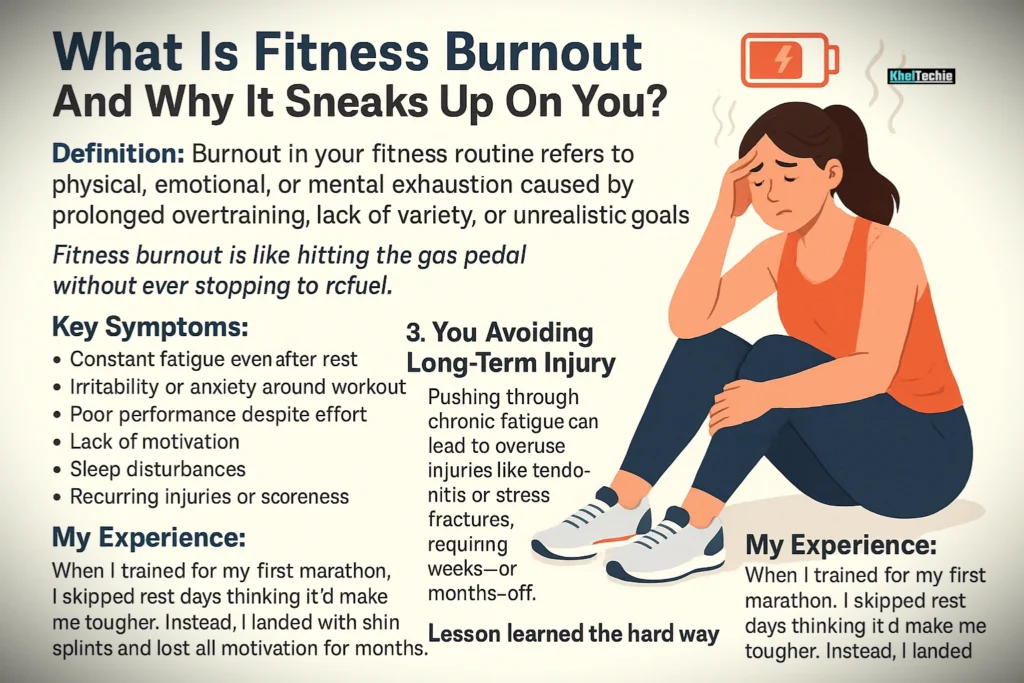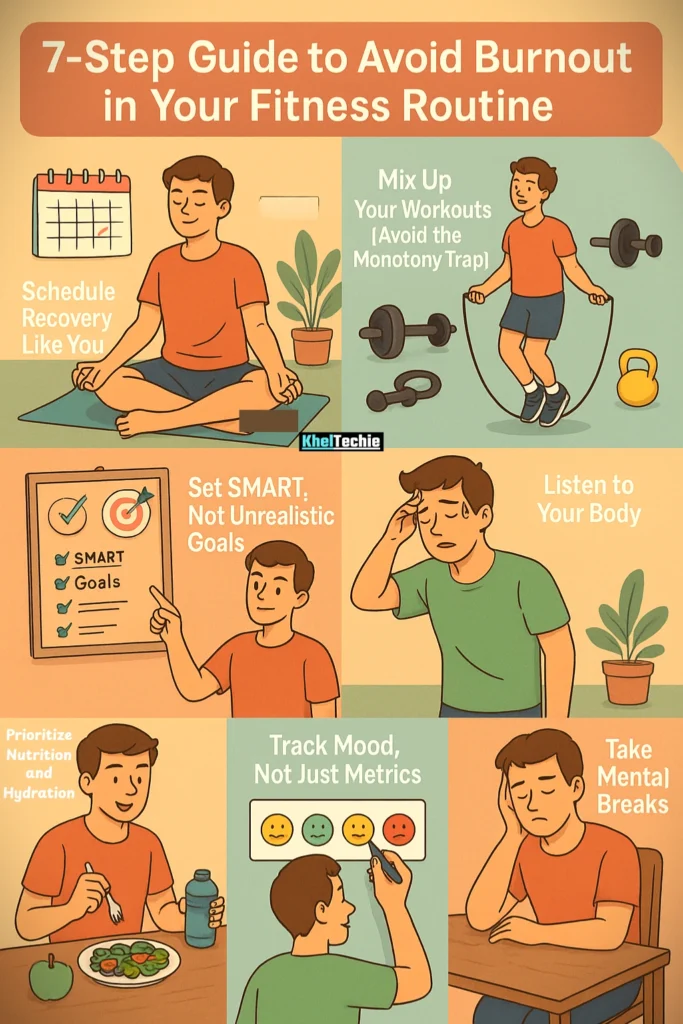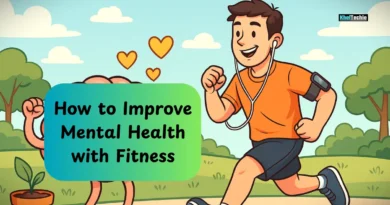How to Avoid Burnout in Your Fitness Routine: Proven Hacks That Actually Work
Ever feel like your workouts are turning into a chore instead of a challenge? You’re not alone. Burnout in fitness isn’t just real, it’s a silent motivation killer. Let’s face it, even the most dedicated gym-goers hit a wall. But the good news? Burnout isn’t the end of the road, it’s a signpost pointing you toward smarter strategies.
In this guide, I Ashish, a fitness enthusiast and health blogger with years of experience, will walk you through how to avoid burnout in your fitness routine while keeping the fire alive 🔥.
Also read : Simple Morning Workout Routine

What Is Fitness Burnout And Why It Sneaks Up On You?
Fitness burnout is like hitting the gas pedal without ever stopping to refuel.
Definition:
Burnout in your fitness routine refers to physical, emotional, or mental exhaustion caused by prolonged overtraining, lack of variety, or unrealistic goals.
Think of your body like a smartphone. If you run too many apps (intense workouts) without charging (rest), it crashes or worse, overheats.
Key Symptoms:
- Constant fatigue even after rest
- Irritability or anxiety around workouts
- Poor performance despite effort
- Lack of motivation
- Sleep disturbances
- Recurring injuries or soreness
Why Avoiding Fitness Burnout Matters
1. It Impacts Your Progress
According to the National Academy of Sports Medicine, overtraining can lead to plateaus or regression in your results, sometimes even muscle loss.
2. Mental Health Takes a Hit
A 2023 survey by Psychology Today found that 46% of fitness enthusiasts reported increased anxiety and mood swings when experiencing burnout.
3. You Risk Long-Term Injury
Pushing through chronic fatigue can lead to overuse injuries like tendonitis or stress fractures, requiring weeks or months off.
My Experience:
When I trained for my first marathon, I skipped rest days thinking it’d make me tougher. Instead, I landed with shin splints and lost all motivation for months. Lesson learned the hard way.

7-Step Guide to Avoid Burnout in Your Fitness Routine
Let’s break this down into simple, actionable steps you can follow starting today.
✅ Step 1: Schedule Recovery Like You Schedule Workouts
Your body builds strength during rest, not during workouts.
Add these recovery tools to your weekly plan:
- Active rest days: Try walking or yoga instead of complete rest.
- Sleep: Aim for 7–9 hours nightly. Lack of sleep = guaranteed burnout.
- Deload weeks: Every 4–6 weeks, reduce intensity to give your body time to repair.
✅ Step 2: Mix Up Your Workouts (Avoid the Monotony Trap)
Doing the same thing over and over? No wonder you’re bored.
Try this rotation:
| Day | Activity |
|---|---|
| Monday | Strength Training (Upper) |
| Tuesday | HIIT or Cardio Kickboxing |
| Wednesday | Yoga or Pilates |
| Thursday | Strength Training (Lower) |
| Friday | Dance or Group Fitness |
| Saturday | Outdoor Walk/Hike |
| Sunday | Rest or Stretch |
✅ Step 3: Set SMART, Not Unrealistic Goals
Unrealistic: “Lose 20 lbs in 2 weeks”
SMART Goal: “Lose 1–2 lbs per week by training 4x weekly and tracking meals”
SMART Framework:
- Specific
- Measurable
- Achievable
- Relevant
- Time-bound
✅ Step 4: Listen to Your Body
If your joints ache or you’re dragging through workouts, stop. Fatigue isn’t weakness; it’s a warning.
Pro Tip: Use the RPE scale (Rate of Perceived Exertion) to check in. On a scale of 1–10, if you’re constantly hitting 9 or 10, dial it down.
✅ Step 5: Prioritize Nutrition and Hydration
Skipping meals or under-fueling will crush your recovery and motivation.
Essentials:
- Lean proteins (chicken, tofu, eggs)
- Complex carbs (quinoa, oats, sweet potatoes)
- Healthy fats (avocados, nuts)
- At least 2–3L of water/day
Add electrolytes during intense sessions to avoid energy crashes.
✅ Step 6: Track Mood, Not Just Metrics
Start a “Workout Journal” to note:
- Mood before/after workouts
- Energy level
- Sleep quality
- Stress levels
This helps catch burnout before it spirals.
✅ Step 7: Take Mental Breaks
Burnout isn’t always physical. Sometimes it’s emotional fatigue.
Mental recharge strategies:
- Meditate or journal for 10 mins daily
- Swap gym time for hobbies once a week
- Listen to motivational podcasts (like The Mindset Mentor or The Rich Roll Podcast)
❌ Common Mistakes That Lead to Fitness Burnout
❌ Ignoring Rest Days
Rest is not laziness, it’s part of the training cycle.
❌ “All or Nothing” Mindset
Missing one workout doesn’t mean the week is ruined. Progress isn’t linear.
❌ Chasing Social Media Goals
Comparing yourself to influencers can lead to dangerous overtraining. Your journey is unique.
❌ Poor Programming
Jumping from one random workout to the next confuses your body and brain, Structure = sustainability.
❌ Not Consulting Professionals
DIY training can work for a while, but if you’re serious, get a certified trainer to personalize your program.
Final Thoughts: Your Fitness Journey Should Energize You, Not Exhaust You
Burnout doesn’t mean you’re weak or failing. It just means you’re human.
By listening to your body, embracing rest, varying your workouts, and tuning into your mental health, you’ll build a fitness routine that fuels you for the long haul.
💬 Got a burnout story or a hack that worked for you? Drop it in the comments below or share this post with a friend who needs it.
🙋 FAQs
How often should I take a break from working out?
Ideally, 1–2 rest days per week. Every 4–6 weeks, take a “deload” week to reduce intensity
Can I still make progress with fewer workouts?
Yes. Consistency beats frequency. Three high-quality workouts > six half-hearted ones
Is burnout a sign I should quit my program?
Not necessarily. It’s a sign you need to reassess intensity, variety, and rest.
How do I stay motivated during a plateau?
Shift focus. Instead of scale weight, aim for strength gains, endurance, or mood improvements
What’s the role of mindset in avoiding burnout?
It’s huge. A positive, flexible mindset keeps you committed even when results are slow.
Should I work out when I’m mentally exhausted?
Light movement can help, but never force high-intensity workouts when drained.
Can burnout affect sleep?
Absolutely, Overtraining can increase cortisol, disrupting sleep cycles
How do professional athletes manage burnout?
With periodization, coaches, recovery routines, and strict mental wellness practices.
What apps can help track burnout?
Try Whoop, Oura Ring, or Fitbit Premium for recovery tracking
When is it okay to take a full break?
If your physical or mental health is suffering, a full break (1–2 weeks) can rejuvenate you completely





Pingback: How To Lose 10kg In 30 Days Naturally – The Reality
Pingback: 9 Best Cardio Workouts Without Running : Take Action Now
Pingback: 10 Best Ab Exercises For A Flat Stomach (No More Fluff!)